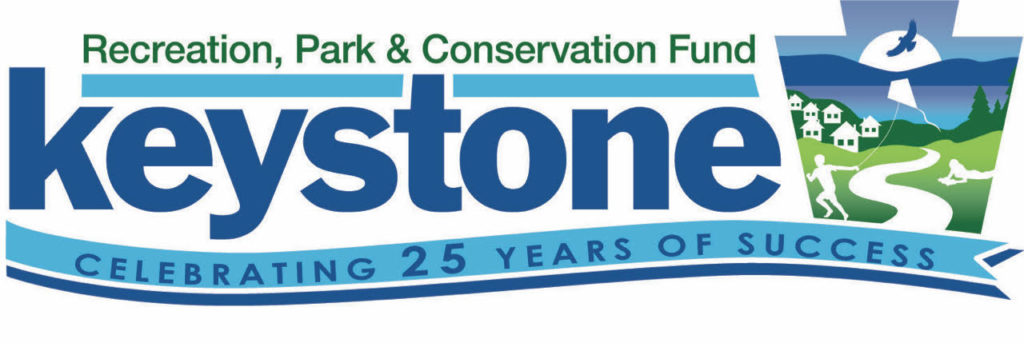One of the most successful preservation programs in Pennsylvania is the Keystone Fund’s Historic Preservation Grant program.
The PASHPO is honored to manage this grant program, connecting much-needed grant funding to communities and non-profit organizations who care for some of the most significant historic and architectural treasures in the Commonwealth. Without this source of grant funds, many of these historic sites would struggle to make capital improvements and preservation interventions.
Granary at Old Economy Village. Photo by PHMC, Bureau of Historic Sites and Museums.
How it All Started
The roots of the Keystone Fund began in 1991, when Pennsylvanians sought to provide a stable source of funding for parks, natural areas, recreation, historic preservation sites, educational facilities, zoos and public libraries. Lt. Governor Mark Singel, Senator, F. Joseph Loeper, Rep. William Lloyd and former Secretary of the Department of Community Affairs Karen Miller were the original champions of what would eventually become House Bill No. 50 introduced in 1993.
The Keystone Recreation, Park & Conservation Fund was established infused with 15% of the state’s realty transfer tax for this specialized initiative. It overwhelmingly passed the legislature and was enacted on July 2, 1993.
The Keystone Fund’s Commonwealth Impact
Certainly, not all of the Keystone Fund is directed to the PHMC to distribute as public grants for preservation. But the Keystone Fund can be seen throughout your local community through the work of our other sister state agencies. The Keystone Fund supports the programming of Pennsylvania Department of Conservation and Natural Resources, State System of Higher Education and the Department of Education’s Community Library program as well.
Learn more at KeystoneFund.org.
These successful projects can be seen throughout the commonwealth in libraries, playgrounds and other recreation facilities, preserved open space, and hiking and bike trails.
The Keystone Fund’s Impact to Preservation in Pennsylvania
One of the great success of the Keystone Fund was the marriage of the preservation of the cultural resources with land conservation and park development. The Pennsylvania Historical and Museum Commission and its mission greatly benefit of this philosophy. Our Commission receives 13% of the Keystone Recreation, Park & Conservation Fund. This funding supports capital improvements and on-going maintenance at the 25 Commonwealth-owned historic sites and museums operated for the public.
Roof Replacement on the Corn Crib at The Highlands, Montgomery County, Photo by PHMC, Bureau of Historic Sites and Museums.
Skilled craftsmen and women have replacement of rotted sills, restored deteriorated windows, repointed masonry and made structural repairs to some of the most significant Commonwealth-owned historic sites. Even the most recent restoration of the State Museum of Pennsylvania’s Mammal Hall was made possible through the Keystone Fund.
Mammal Hall Restoration at the State Museum of Pennsylvania, Photo by PHMC, State Museum of Pennsylvania.
The Keystone Fund has the greatest impact to our partners however. It remains one of the only grant programs to provide support for capital improvements at historic sites listed in or eligible for listing in the National Register of Historic Places. Grants may only be directed to properties owned by non-profit organizations or local governments, but the program ensures that these properties may be shared with the public to experience Pennsylvania’s rich history and culture.
Our partners have used Keystone grants to preserve a diverse array of Pennsylvania’s cultural landscape. Rollercoasters, covered bridges, industrial sites, churches, theaters and museums all benefitted through the program. In 2010, the PHMC also launched a smaller companion grant program to provide funding to planning initiatives in communities and at historic sites.
The Academia-Pomeroy Covered Bridge, Juniata County, photo by PHMC Grants Staff.
Including our most recent round of Keystone awards, I’m proud to share that the PHMC has supported over 750 projects in both the planning and construction categories, investing over $37.5 million in local communities. Those grant funds leveraged an astounding $156.3 million investment by our partners as match to the Commonwealth’s share.
Join the Celebration!
With our Silver Anniversary, I would love to hear from some of our past grant recipients firsthand how your community has benefited from the Keystone fund – and take the opportunity to share this milestone with your members and visitors.
- Feel free to use the Keystone Fund anniversary hashtag (#KeystoneFund25, #KeystoneFund) on social media posts through the fall.
- If you host an event at a site previously funded through Keystone Fund grants, you already have a great springboard for showcasing Keystone! Be sure to mention the role Keystone Fund played in enhancing or rehabilitating the property.
- Learn more about the Keystone Fund. There are several fact sheets available at keystonefund.org/fact-sheets.
- Share your story of success with us. We would love to know the impact the Keystone fund has had to improving the visitor experience and appreciation of your site. Check out other testimonials at keystonefund.org/success-story/.
- Check out the Pathways to the Future Exhibit in the Pennsylvania State Capital’s Lower Rotunda September 17-21st to see photographs of a select few of the great community projects made possible through the Keystone Fund.
Watch for upcoming announcements for our next application round for fiscal year 2018-2019 and view the grant guidelines at https://www.phmc.pa.gov/Preservation/Grants-Funding/Pages/default.aspx.
